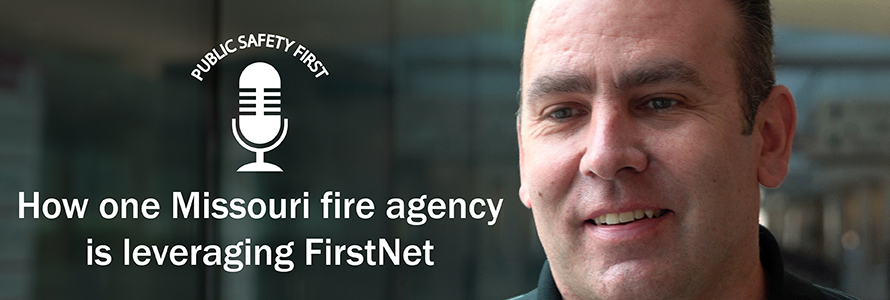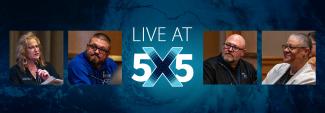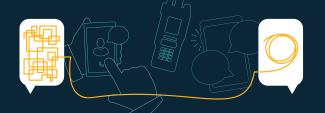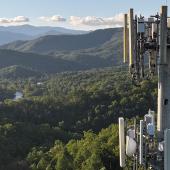Summary
Southern Platte Fire District in Missouri uses FirstNet and its push-to-talk capabilities to enhance daily operations.
Guest
Dave Buchanan
FirstNet Authority Executive Director of Public Safety Advocacy
Chris Denney
Division Chief, Southern Platte (Missouri) Fire Protection District
Transcript
Preview
Narrator: You're listening to Public Safety First, a podcast to help you learn about the First Responder Network Authority and how you can be part of the future of public safety technology.
And now your host, Dave Buchanan.
Narrator: You're listening to Public Safety First, a podcast to help you learn about the First Responder Network Authority and how you can be part of the future of public safety technology.
And now your host, Dave Buchanan.
Dave Buchanan: Hello, and welcome to the Public Safety First podcast. This is Dave Buchanan from the FirstNet Authority, and I’m in Baltimore, Maryland, at the APCO [Association of Public-Safety Communications Officials] Conference, where we just released our new Roadmap. For those of you who have been listening to previous episodes, you know we’ve been working all year on producing the new Roadmap for first responders and public safety to really capture their inputs and direction and priorities for the future of the network as we look forward to making investments this year and into the future. We’re going to use this Roadmap to help us ensure that those dollars are being spent on enhancements and improvements that public safety needs the most.
I’m delighted to be joined today by Chris Denney, Division Chief of the Southern Platte Fire District in Missouri. Welcome to the podcast, Chris.
Chris Denney: Well, thanks for having me.
Dave Buchanan: So this is your first APCO. What have you been doing and what are your thoughts?
Chris Denney: So, it’s been overwhelming. APCO is pretty big. It’s really neat to see because it’s technology and the fire service, public safety, communications all coming together and displaying everything that is available to all of us as public safety entities.
Dave Buchanan: The First Responder Network Authority is here at APCO. We have a whole track this year, thirteen different sessions, and you had a chance to be one of our panelists. What was the topic, and what did you discuss?
Chris Denney: So our panel was local control and how we’re using it from a user perspective.
Dave Buchanan: Tell me a little bit about your background. How did you get into the fire services, and what’s your job today?
Chris Denney: I had two passions in life. I had public safety, fire service, saving lives and property, and I had technology. I did both of those up until the year 2009, and I had to make a choice. In 2009, I made the choice to leave the fire truck and handle all the technology for the Fire District.
I made my way through the ranks. I started in 1994, so this is actually my 25th year. I worked my way up as a captain, and left the truck in ’09. I actually left the ranks and became the Director of Technology of the Fire District and was brought back to the ranks in 2015 to become their Division Chief, and I oversee all technology for the Fire District.
Dave Buchanan: So what’s an average day for you include?
Chris Denney: So, the story that I give people is: I’m in charge of all things that have a battery or a circuit board in them. So, that is everything from servers, workstations, telephones, cell phones, internets, you name it – FirstNet devices, local control, push-to-talk. So yeah, everything. What is a day? Every day is different. Monday’s are horrible just because it’s pile up of the weekend, but it calms down come Friday.
Dave Buchanan: Your fire district became FirstNet customers. Talk a little bit about what that’s been like, and how are you using those devices?
Chris Denney: FirstNet is an amazing solution. It’s something that’s been needed for a long time. I’m glad it’s here. We love it; we use it from a daily basis. Every single one of our first-out units, so they carry a FirstNet device, a FirstNet rugged device. We have deployed the push-to-talk app. We use push-to-talk on a daily basis. We also use push-to-talk for special events and things of that nature. We also have the dispatch console, so if we need to spin out the dispatch console to handle some sort of special traffic that we don’t necessarily want to use on the P25 system, that’s what we’ll do. But everything FirstNet, we are heavily involved in.
All of our first-out units, they all have mobile data terminals within them. In those is an AVL [automatic vehicle location] product that I am in the process of rolling over to FirstNet as we speak. So this year is the year that I’m slated to have everybody moved over to a FirstNet device.
Dave Buchanan: And so you’re using a ruggedized FirstNet device, you’re using push-to-talk. Tell me a little bit about what that looks like, and how have the firefighters adopted and accepted it as a everyday tool?
Chris Denney: We have a fairly young force, and you’ve heard me in various presentations say, or make reference to, Nextel. I was a giant fan of Nextel, was super sad when Nextel disappeared. Super excited with this push-to-talk as it is basically Nextel at the next level. All of our trucks use it, they use it on a daily basis. Instead of making that phone call to communicate with each other, they will just do the push-to-talk app. “Hey, just to let you know, this is what we’re doing, this is where we’re going to be at.” So we make sure to keep our fire district covered and we don’t off balance the coverage.
Dave Buchanan: Everyone is issued their own device or do they share the devices?
Chris Denney: So for our on-duty personnel, they have what we call a “duty phone.” Each pumper or each truck has a duty phone, as well as our battalion chief. We do have captains that will work out of class as a battalion chief, that’s why the battalion chief position has a duty phone. Our battalion chiefs and above have a FirstNet-issued device. It’s an agency-paid device, but we also have subscriber-paid devices that we allow anybody and everybody to subscribe to.
Dave Buchanan: And how else are they using the devices?
Chris Denney: From a agency-paid perspective, I run an MDM [mobile device management system] where I am able to push the applications that we as an organization want them to have. So they’re using it from a daily basis for anything fire-service-related. We have our ERGs [emergency response guidebooks] deployed on them, we have our daily staffing. We also have many other applications that are related to the fire service deployed, so that they can use them on a daily basis, and then if they come to me and determine that they have something that needs to be deployed, then I’ll deploy it to the whole group.
Dave Buchanan: And what was the decision like for you and your department? Was it much of a decision? Did you have a lot of, sort of, hand-wringing over it to adopt this new service?
Chris Denney: I am not one that jumps on something day one. I kind of wait for the newness to kind of settle down a little bit, work out the initial bugs, work out the initial problems or complications because with anything new comes with its own challenges. So, I gave it a little bit and then saw that everything was where it needed to be and deployed, not just individually, but deployed as an organization.
Dave Buchanan: So you had a chance to participate in one of our Roadmap meetings earlier this spring, and you’ve seen the topics and now you’ve seen the Roadmap get released today. What are some of the priorities and issues that are important to you and important to your fire department?
Chris Denney: A good portion of our fire district is rural, where there’s no hydrants. Well, where there are no hydrants, there’s typically no coverage. We have holes in our P25 [Project 25] systems, so if those holes are covered up by the FirstNet system, then this is going to be a true benefit to us because our current deployment is we are working towards an LMR [Land Mobile Radio] integration. So the fact that we’ll be able to integrate our land mobile radios with FirstNet and the push-to-talk is going to really, truly seal up those holes, and that’s really what’s going to be exciting. But, so to answer that a little bit more, it’s coverage. Coverage, coverage, coverage. If we don’t have coverage, how can we communicate?
Devices. Devices are obviously important. And then apps. Make sure that we have all of the apps that are necessary, and everything that we can use.
Dave Buchanan: So, you spoke yesterday on the panel regarding local control. Talk a little bit about how that platform works for you, and how do you use it in your job?
Chris Denney: So, local control, as you’ve heard me say in other presentations, local control is the one-stop shop for everything you need to do FirstNet. So, if I need to do anything in the FirstNet system, I go to local control first. That’s where I am able to manage my users, manage all of my billing information, as well as services and phone stuff.
Move over to the corporate admin tool – that’s where I’m able to administer the push-to-talk features, the push-to-talk talk groups, as well as putting people where they need to be in those respective talk groups.
Dave Buchanan: You mentioned your LMR system and the effort to really bring those networks together. Where are you with that?
Chris Denney: So, we are in the very first initial infancy testing phase, and the reason I say that is I am working with a radio system that I do not manage. It is a radio system that we are on that’s managed by the Kansas City – by Kansas City Police Department, their radio shop manages the entire radio system, and we are part of Kansas City Fire’s deployment. When we got rid of our borders, for lack of a better term, we became part of Kansas City Fire’s system, so add four more stations to their deployment model and their CAD [computer-aided dispatch] system. So, I have to be careful on what I do just because it’s not a system that I manage, nor is it a system that I’m responsible for.
So, I’m currently in a testing phase that I will be, once we get things – the necessary equipment deployed – I will be testing with certain people in the Kansas City system, just to verify it’s going to work like we want it to, it’s not going to cause any issues in the system, and I continue to run our old VHF [very high frequency] system. We’ll use that for special events, or anything that we don’t necessarily want to deploy or use on the Kansas City system, just not to burden the system itself, so we’ll use that for special events, Fourth of July, we have an event called Christmas on the River, we’ll use our VHF system for that, so we’ll probably use the push-to-talk for that as well. Because, in all honesty, these push-to-talk devices have a lot lower price point than the radios.
Dave Buchanan: Have you had any conversations with any neighboring jurisdictions or other first responders?
Chris Denney: Not an immediate neighbor, but there’s another jurisdiction locally in the Kansas City metropolitan area. They run the dispatch console, they have deployed their land mobile radio integration. So, it’s getting more and more popular as people are becoming more familiar with it.
Dave Buchanan: Yep. We really appreciate your time today, Chris. We’re really grateful for your support. We’re grateful for the support of Chief Carrizo, who many of our listeners may know is on our FirstNet Board. We really appreciate your time today, and best of luck with you and your job.
Chris Denney: Absolutely. Can’t thank you enough for the opportunity. FirstNet is definitely something that has been needed by this entire country for quite a while.
Narrator: Thanks for listening today. We're excited to have you join our podcast community. Make sure to subscribe on iTunes, SoundCloud, and YouTube. You can learn more about the First Responder Network Authority at FirstNet.gov and learn about FirstNet products and services at FirstNet.com.























